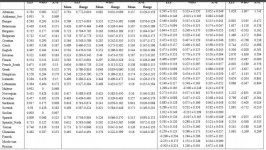I think that for quite some time, at least as far as the European Neolithic is concerned, we may have been getting hung up on making distinctions that don't much matter, in my opinion. The question that has engaged archaeologists and anthropologists and population geneticists for so long has been, first, did the Neolithic spread through cultural diffusion or population movement? The resoundingly clear answer is that it came from population movement from the Near East. Then the question is how much of the ancestry of modern Europeans is attributable to that population movement?
We have an LBK farmer, Stuttgart, who stands for EEF, and so we know how related modern Europeans are to her.
Now, the question is whether Stuttgart is basically the same as the farmers who came from the Near East into Europe. The genome of this farmer isn't as high quality as we would like, and maybe things will look different if we get a better quality genome from further down the coast where, if Paschou et al are correct, and no one has proven that they aren't, the farmers started peeling off by boat for Greece.
With that caveat in mind, I think we can draw some preliminary conclusions if we look at some of the lower K runs (I think that's a better bet given the fact this is such a poor quality specimen.) From those runs it looks to me as if Stuttgart is largely just a transplanted ancient Near Eastern farmer. I mean, in K-7b she's about 4 points different, and in the Eurogenes K8 about 10 points different, yes?
@Fire Haired
Given all of this, shouldn't we be lowering the EEF figure by 10 at the most to get ancient Near Eastern farmer or ancient Anatolian farmer if you want to put it that way, input
if we use this genome? Given that, southern Europeans would be
at least 60% ancient Near Eastern farmer, the English and Central Europeans 40-45% and so on?
Here's the chart:

@ Maleth @ Arvistro,
I totally agree. I think we're getting lost in the weeds here. I mean, how would ENF even be defined geographically and temporally? Is there even any agreement about that? The Natufians weren't yet farmers, so I don't think they fit the bill. There are other choices, however., assuming we can settle on a time. Is it the farmers on the hillsides in the interior of Anatolia, the farmers in the Jordan valley, the farmers along the coast between Syria and southeastern Anatolia, or is it the ones further up the coast toward Greece? If they all turn out to be about the same, great, but what if they're all slightly different? How do you choose? Does it ultimately even matter? I'm sure there were probably successive waves, but they all came from the same part of the world.
The upcoming sample from Jordan will be interesting, especially if it's high coverage, but would those people necessarily be exactly the same as those who went to Europe? Maybe we'd be better off with a sample from a group that was already on its way, so to speak?
There are large implications, obviously, for the population genetics of the Near East, including Anatolia, in all of this. Just off the cuff, if Stuttgart (EEF) or this sample are representative of the population that was all over the Near East at this period, then there have indeed been a lot of changes, perhaps coming from the south as well as the east. If there was a lot of regional substructure, then the analysis will be more complicated and different as to how much population replacement has taken place. I think we have to consider, however, that the difference all over the Near East might owe a lot to the migration of different y lines and also to drift, which people are tending to forget in recent years. Other than the minority portion of U4 and U5, most of the mtDna of Europeans is very much like that from the Near East.
Anyway, the role of the "WHG" in all of this really has to be examined as well. If it runs from North Africa, throughout Europe and into the Near East, is it really a EuroHG, as has been proposed? I suppose it partly depends how far down into the Levant and how far east it goes in Anatolia. I know it's in western North Africa. Does it peter out right when you get to Egypt? Might that be because of constant gene flow up the Nile? Or are we looking at this the wrong way around? Are the WHG the Gravettians who came into Europe from the Near East in the first place? Depending on how far down it goes, the question then becomes, were the people who invented farming a fusion of these "ancestral" Gravettians and a people like the Natufians? At any rate, the WHG in this sample, if we take the Eurogenes run at face value is 20%, so the vast majority of the hunter gatherers who went into the genesis of these Anatolian Neolithic people were not WHG like...
@Maciamo,
I agree with much of this. As far as the Mediterranean is concerned, the Neolithic was like a bifurcated stream that followed along both the northern and southern littoral, bringing both the technology and the people who invented it. It also went down south east to India and up through Iran.
In this fascination and emphasis on migration, which was no doubt necessary in order to overcome the mindset of years where virtually Paleolithic Continuity was contemplated everywhere, some people have tended to overlook the function of drift in many of these populations.
@Alan,
As I said above, I wouldn't go with a K12 for something as poor quality as this. I think all those results show, as Maciamo pointed out, is the big portion of Neolithic era genes in North Africans.


